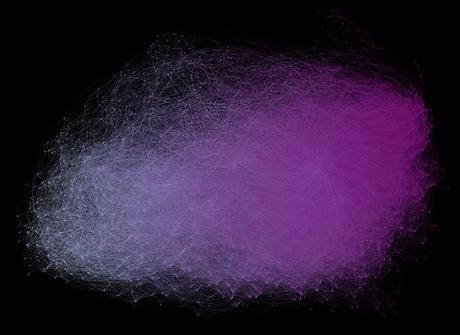Let us start with a thing. What is this?

If you are a regular reader here at New Savanna you might reply: Oh, that’s the whatchamacallit from Jocker’s Macroanalysis. Well, yes, it’s an illustration from Macroanalysis. But that’s not quite the answer I was looking for. But let’s call that answer a citation and set it aside.
Let’s ask the same question, but of a different object: What’s this?

I can imagine two answers, both correct, each it its own way:
1. It’s a photo of the moon.Strictly speaking, the first is correct and the second is not. It IS a photograph, not the moon itself. But the second answer is well within standard usage.
2. The moon.
Notice that the photo does not depict the moon in full (whatever that might mean), no photograph could. That doesn’t change the fact that it is the moon that is depicted, not the sun, or Jupiter, or Alpha Centauri, or, for that matter, Mickey Mouse. We do not generally expect that representations of things should exhaust those things.
Now let us return to the first image and once again ask: What is this? I want two answers, one to correspond with each of our answers about the moon photo. I’m looking for something of the form:
1. A representation of X.Let us start with X. Jockers was analyzing a corpus of roughly 3300 19th century Anglophone novels. To do that he evaluated each of them on each of 600 features. Since those evaluations can be expressed numerically Jockers was able to create a 600-dimensional space in which teach text occupies a single point. He then joined all those points representing texts that are relatively close to one another. Those texts are highly similar with respect to the 600 features that define the space.
2. X.
The result is a directed graph having 3300 nodes in 600 dimensions. So, perhaps we can say that X is a corpus similarity graph. However, we cannot see in 600 dimensions so there is no way we can directly examine that graph. It exists only as an abstract object in a computer. What we can do, and what Jockers did, is project a 600D object into two dimensions. That’s what we see in the image.
Now we have:
1. A 2D representation of a corpus similarity graph.But that corpus didn’t come out of nowhere. Each text in the corpus was written by someone, published by someone else, and read by others. Some were read by a relative handful of people while others have been read by 100s of thousands, perhaps even millions, over the years. Some of them are still being read, while most of them are forgotten.
2. A corpus similarity graph.
However it is that Jockers was able to assemble this corpus in the early 21st century and then analyze, it originated in a rich and complex historical process that evolved through the 19th century Anglophone world. Thus we might argue that is a component of something like the collective 19th century Anglophone mind. That’s what philosophers at the time thought of as Geist or Spirit – hence the title of this post (for further explanation, see this post, and this one).
For obvious reasons I do not want to introduce either term as a term of art in the study of cultural evolution, but it’s not clear to me just what I should call that object. For the moment let’s just call it the 19th century collective mind (though see the entry for “reticulum” in my list of terms for cultural evolution). That gives us a third answer to our question: What is this?
3. The 19th century collective mind.And just as the moon photo doesn’t represent the moon in full, so that image doesn’t represent the 19th century collective mind in full. It is just some aspect of that thing, that abstract object (one of Tim Morton’s hyperobjects?), that 19th century collective mind.
With that, however, we can proceed on.
Last week I did a post on a paper by Olivier Morin & Alberto Acerbi, Birth of the cool: a two-centuries decline in emotional expression in Anglophone fiction. They document “a decrease in emotionality in English-speaking literature starting plausibly in the nineteenth century.” Are they not measuring the 19th century collective mind? That is, are they not measuring the cultural object that Jocker’s represented in his corpus similarity graph, which is in turn depicted in the illustration at the head of this post?
In a similar fashion Ryan Heuser and Long Le-Khac documented a shift from abstract to concrete words, from telling to showing in 19th century British novels, A Quantitative Literary History Of 2,958 Nineteenth-Century British Novels: The Semantic Cohort Method (68 page PDF). Is that not another measurement of that same cultural object, the 19th century collective mind?
But why do I say that Jockers is representing that object in his visualization while Morin and Acerbi, on the one hand, and Heuser and Le-Khac, in the other, are measuring that object? Is that a tenable distinction? If so, on what basis? It conventional to assert that my photograph represents, rather than measures, the moon. Is that mere semantics?
I don’t know.

